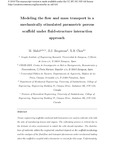Mostrar el registro sencillo del ítem
Modeling the flow and mass transport in a mechanically stimulated parametric porous scaffold under fluid-structure interaction approach
| dc.creator | Malvè, Mauro | es_ES |
| dc.creator | Bergstrom, Donald | es_ES |
| dc.creator | Chen, Xiongbiao | es_ES |
| dc.date.accessioned | 2019-11-14T17:21:34Z | |
| dc.date.available | 2020-08-01T23:00:17Z | |
| dc.date.issued | 2018 | |
| dc.identifier.issn | 0735-1933 | |
| dc.identifier.uri | https://hdl.handle.net/2454/35389 | |
| dc.description.abstract | Tissue engineering scaffolds combined with bioreactors are used to cultivate cells with the aim of reproducing tissues and organs. The cultivating process is critical due to the delicate in-vitro environment in which the cells should reproduce. The distribu- tion of nutrients within the engineered construct depend on the scaffold morphology and the analysis of the fluid flow and transport phenomena under mechanical loading when the scaffold is coupled with a bioreactor is crucial for this scope. Unfortunately, due to the complicated microstructure of the scaffold, it is not possible to perform this analysis with experiments and numerical simulation can help in this sense. In this study we have computed the fluid flow and the mass transport of a parametrized scaffold in perfusion bioreactors analyzing the influence of the microstructure of the scaffold using the fluid-structure interaction approach. The latter allows considering the porous construct as compliant yet determining important structural parameters such as stresses and strains that could be sensed by the cells. The presented model considered flow perfusion that provided nutrients and mechanical compression. In particular, we have studied the effect of controllable parameters such as the diam- eter of the scaffold strand and the porosity on the mechanical stresses and strains, shear stress and mass transport. The results of this work will help to shed light on the necessary microenvironment surrounding the cultivated cells improving culturing scaffold fabrication. | en |
| dc.description.sponsorship | The authors acknowledge the financial supports to this project from the Spanish Ministry of Education, Culture and Sport via the National Program“Salvador de Madariaga”(PRX17/00335) and the Saskatchewan Health Research Foundation via the Health Research Group Program (SHRF Reference #2784). Also, the authors thank the CIBER-BBN financed by the Instituto de Salud Carlos III and the Spanish Ministry of Education, Industry and Competitiveness via the research project (DP12017-83259-R). | en |
| dc.format.extent | 22 p. | |
| dc.format.mimetype | application/pdf | en |
| dc.language.iso | eng | en |
| dc.publisher | Elsevier | en |
| dc.relation.ispartof | International Communications in Heat and Mass Transfer 96 (2018) 53-60 | en |
| dc.rights | © 2018 Elsevier Ltd. The manuscript version is made available under the CC BY-NC-ND 4.0 license. | en |
| dc.rights.uri | https://creativecommons.org/licenses/by-nc-nd/4.0/ | |
| dc.subject | Scaffold | en |
| dc.subject | Mass transfer | en |
| dc.subject | Bioreactor | en |
| dc.subject | Tissue engineering | en |
| dc.subject | Mechanical stimulation | en |
| dc.subject | Fluid-structure interaction | en |
| dc.title | Modeling the flow and mass transport in a mechanically stimulated parametric porous scaffold under fluid-structure interaction approach | en |
| dc.type | Artículo / Artikulua | es |
| dc.type | info:eu-repo/semantics/article | en |
| dc.contributor.department | Ingeniería | es_ES |
| dc.contributor.department | Ingeniaritza | eu |
| dc.rights.accessRights | Acceso abierto / Sarbide irekia | es |
| dc.rights.accessRights | info:eu-repo/semantics/openAccess | en |
| dc.embargo.terms | 2020-08-01 | |
| dc.identifier.doi | 10.1016/j.icheatmasstransfer.2018.05.014 | |
| dc.relation.projectID | info:eu-repo/grantAgreement/AEI/Plan Estatal de Investigación Científica y Técnica y de Innovación 2013-2016/DPI2017-83259-R/ES/ | en |
| dc.relation.publisherversion | https://doi.org/10.1016/j.icheatmasstransfer.2018.05.014 | |
| dc.type.version | Versión aceptada / Onetsi den bertsioa | es |
| dc.type.version | info:eu-repo/semantics/acceptedVersion | en |



